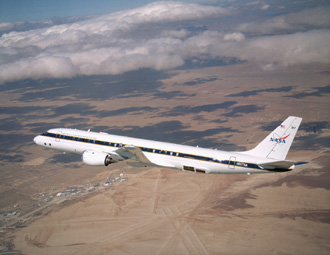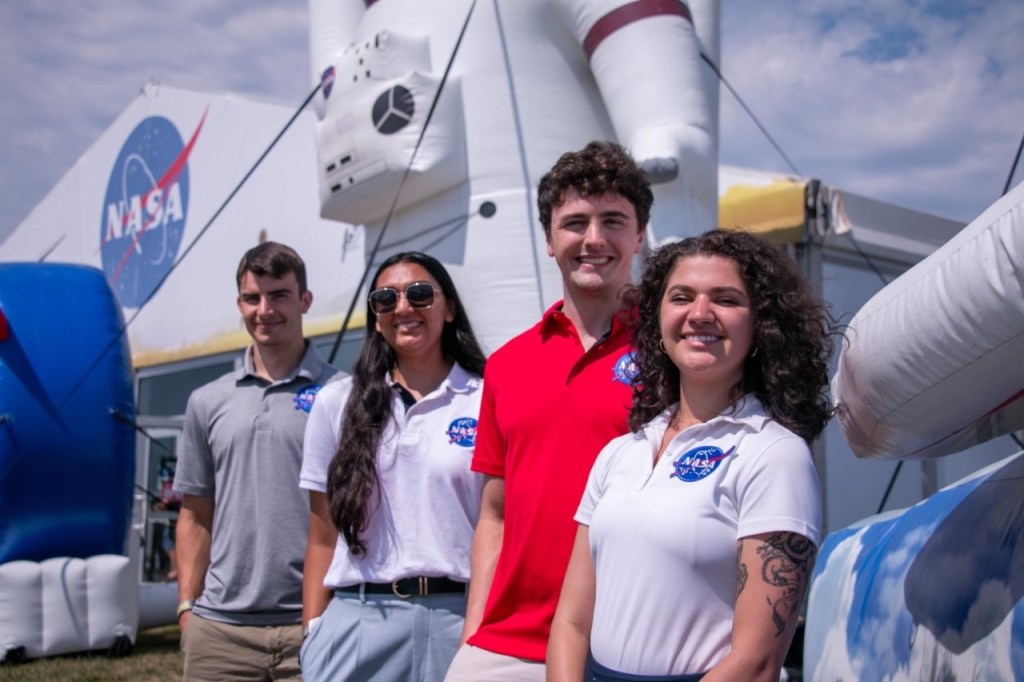An international team of scientists has embarked on a journey this week to improve modeling of global scale air quality and climate change predictions by conducting high quality measurements of the arctic region’s atmosphere.
 The Polar Aura Validation Experiment (PAVE) is gathering information to validate data from NASA’s Aura satellite, launched in July 2004. PAVE is the third in a series of planned Aura validation and science missions to help understand the transport and transformation of gases and aerosols in the lower atmosphere (troposphere) and their exchange with those in the lower stratosphere. The mission began Jan. 24 and continues through Feb. 9.
The Polar Aura Validation Experiment (PAVE) is gathering information to validate data from NASA’s Aura satellite, launched in July 2004. PAVE is the third in a series of planned Aura validation and science missions to help understand the transport and transformation of gases and aerosols in the lower atmosphere (troposphere) and their exchange with those in the lower stratosphere. The mission began Jan. 24 and continues through Feb. 9.
Image Right: NASA’s Airborne Science DC-8, displaying new colors in a check flight Feb. 24, 2004, over the Dryden Flight Research Center. NASA Photo EC04-0047-04 by Jim Ross.
“In addition to providing important validation for the various Aura data products, PAVE brings together a full NASA complement of space-based and suborbital measurements to study the atmospheric chemistry and transport of gases and aerosols in this sensitive region of our planet,” said Dr. Michael Kurylo, Program Scientist for PAVE at NASA Headquarters in Washington, DC. “The information obtained from this campaign will aid in understanding how changing atmospheric composition associated with climate change might affect the recovery of the Earth’s ozone layer that is anticipated to occur over the next several decades.”
In particular, PAVE is focusing on the high latitude (Arctic) region of the Northern Hemisphere, where winter chemistry has led to significant seasonal reduction of the stratospheric ozone layer in many years over more than a decade. The ozone layer restricts the amount of the sun’s ultraviolet radiation that reaches the Earth. Depletion of this protective layer can thus have harmful effects on humans and other ecosystems.
NASA’s DC-8 flying laboratory and high-altitude balloons are collecting valuable science data, especially on ozone and ozone-destroying chemicals, using a suite of atmospheric remote sensing and in situ instruments. The aircraft, operated by NASA’s Dryden Flight Research Center at Edwards, Calif., is flying the PAVE mission from Pease International Tradeport, Portsmouth, N. H. Balloons are being launched from the European Sounding Rocket Range (ESRANGE) facility in Sweden.
The study is focusing on obtaining in situ and remote sensing measurements of the Arctic region for validation of the Aura satellite. Information gathered during PAVE will be combined with data from Aura to improve modeling of global scale air quality, ozone and climate change predictions.
Instruments onboard the DC-8 are characterizing upper tropospheric and stratospheric gases inside and outside the Arctic polar region to study ozone depletion chemistry. Such flights will also permit measurement of the outflow of gases from the North American continent thereby contributing to an understanding of how regional pollutants are distributed on a hemispheric basis. Scientists will make remote sensing measurements (extending many kilometers away from the aircraft) of tropospheric and stratospheric ozone, aerosols, temperature, nitric acid, HCl, ClO and other ozone-related chemicals. These are complemented by measurements (such as ozone, methane, water vapor, carbon monoxide, nitric acid, and nitrous oxide) in the atmosphere immediately surrounding the aircraft.
“The DC-8 will perform a number of specialized maneuvers to permit concurrent flights under the path of the Aura satellite and to sample the concentration of ozone at very high latitudes,” said Walter Klein, Dryden’s mission manager for the project. “The aircraft is carrying 13 instruments, weighing more than 20,000 pounds, and a complement of 40 scientists, engineers and technicians in support of PAVE.”
“PAVE is designed to validate satellite data from the newly launched Aura mission,” added Mark Schoeberl, PAVE co-project scientist and Aura project scientist at NASA’s Goddard Space Flight Center, Greenbelt, Md. “Aura contains four instruments including the Dutch Ozone Monitoring Instrument and the joint U.S.-U.K. High Resolution Dynamics Limb Sounder. Both Dutch and U.K. representatives will be in the field as part of the validation program.”
NASA scientists from Dryden, Goddard, Ames Research Center, Moffett Field, Calif., Langley Research Center, Hampton, Va., and the Jet Propulsion Laboratory, Pasadena, Calif., are participating in PAVE. Major PAVE partners include the University of New Hampshire, University of California-Berkley, University of Bremen, National Center for Atmospheric Research (NCAR), the U.S. Naval Research Laboratory, Koninklijk Netherlands Meteorological Institute and Los Gatos Research Inc.
For more information about PAVE on the Web, visit: http://cloud1.arc.nasa.gov/ave-polar/
For more information about the Aura mission on the Web, visit: http://aura.gsfc.nasa.gov/
Photos of NASA’s DC-8 are available on the Web at: http://www1.dfrc.nasa.gov/Gallery/Photo/DC-8/index.html
Television Editors: A Video File on the PAVE mission incorporating interview segments and b-roll footage is scheduled to be fed on NASA Television on Jan. 27 – 28. NASA Television is available in the continental United States on the AMC-6 satellite, at 72 degrees west longitude, transponder 9, 3880 MHz, vertical polarization, audio at 6.8 MHz. In Alaska or Hawaii, NASA TV is available on AMC-7, at 137 degrees west longitude, transponder 18, at 4060 MHz, vertical polarization, audio at 6.8 MHz.
– end –
text-only version of this release
To receive status reports and news releases issued from the Dryden Newsroom electronically, send a blank e-mail message to dfrc-subscribe@newsletters.nasa.gov. To unsubscribe, send a blank e-mail message to dfrc-unsubscribe@newsletters.nasa.gov. The system will confirm your request via e-mail.
Dryden Flight Research Center
P.O. Box 273
Edwards, California 93523
Phone 661/276-3449
FAX 661/276-3566
Beth Hagenauer
NASA Dryden Flight Research Center
Phone: 661/276-7960
beth.hagenauer@dfrc.nasa.gov
Gretchen Cook-Anderson/Dolores Beasley
Headquarters, Washington
Phone: 202/358-0836/1753
























